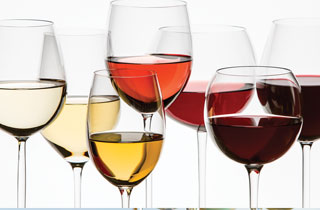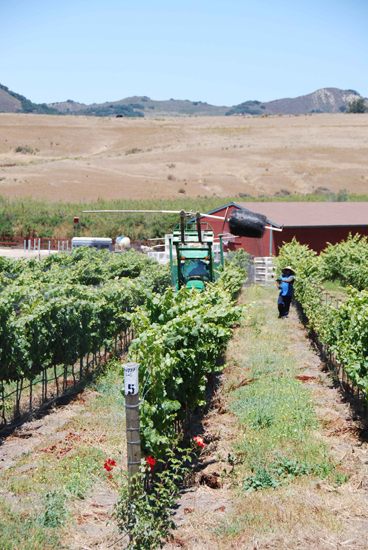(Another) Year in the Vineyard
Week #32 (The Last Weekly Blog for 201)
October 15-21, 2010
Wrapping it Up and Looking to the Skies
For a harvest that began so quickly behind a strong period of hot weather in late September, the harvest is winding down slowly here in Santa Barbara County. We would be done, completely done, tomorrow if our production was strictly pinot noir and chardonnay from the Estate, but we also make some wine for our second label, Axis Mundi, from the Ballard Canyon subarea of the Santa Ynez Valley…and we haven’t seen enough heat to push the syrah and grenache fruit into the ‘ripe’ category. So we press on in the winery (accurate, as we are pressing the last 4 fermenters of Estate pinot noir this morning (Wednesday, October 20th), and then we’ll rack the almost-finished-fermenting chardonnay tomorrow. At that point the Clos Pepe Estate production will be in the can, finished, which will be a relief in itself. We will clean all the equipment and tidy the winery, but we will also know that we will need to have everything ready for one more rodeo—three or four more fermenters of Axis Mundi blended red Rhone wine. So the end of the Estate harvest cannot be seen as purely celebratory. But hey—we’ll get a week or so with no punchdowns.
Video of Fruit Checking in Ballard Canyon, Grenache and Syrah:
The fields here at Clos Pepe have been empty and quiet since last Friday when we finished our last pick for the Loring Wine Company. Since we’ve been ‘picked out’ the strongest October rains I can remember in my 15 years in the Santa Rita Hills have dumped a few inches of rain on the vineyard. Brilliant and helpful for our pinot noir, but retarding ripeness in our syrah and grenache some fifteen miles away. When harvest is over at any vineyard, the vines, relieved of their grape crop, dows two things. First, it takes a portion of its leftover nutrient store and pushes a root flush—a rapid period of root growth that will improve root structure and coverage in subsequent vintages. Then, with whatever stores the vine has retained, it changes them into a form of arginine (amino acid) and puts them into the trunk and tap root for the winter. This is like a squirrel putting a nut away for the winter.
Cultivation, cover crop and sheep: I can see from my window here at my desk the crew outside in the vineyard, working in yellow rain jackets in a light Santa Rita Hills mist. Felipe and Miguel are working on getting the nets bundled and stored, and Cesar is on the tractor cultivating. The early rains were perfect for the vineyard here at Clos Pepe—they are helping to sprout all the weed seeds from last year so we can germinate and then destroy them with the cultivator, so we’ll have a perfect, blank canvas for drilling (planting0 our cover crop for the winter. The rains also give the vines a nice, deep drink that they need after the harvest. When the cover crop is drilled and begins to emerge, we will take the sheep and their guard dog, Gaius, into the vineyard, put up a fence around a few acres at a time, and wait for the sheep to knock the cover crop down to fairway length before rotating them to other acreage on the property. They will convert the cover crop into manure, an amazingly healthy treat for the vines in the vintages to come.
Video of Barrel Work and Punchdown:
Pressing and racking: With the fields picked out, we’ve been spending a lot of time in the winery, getting the Clos Pepe Estate wines polished and barreled. This week we pressed off the last four fermenters of pinot noir, and plan to combine the partial barrels of Chardonnay (partial so they dopn’t overflow during barrel fermentation) into full barrels. At that point on Friday, the entire Estate program will be finished and all that there will be left to do is to keep the barrels topped, make sure the chemistry is good with lab samples, and watch an amazing vintage evolve over the next 11 months. The exact nature of this week’s barrel work and pressing is shown in the video below.
Video of Pressing and Evaluating Pinot Noir, 2010:
Visitors and interns. Adrien Gautherin, our intern from Chablis, France, will be leaving in less than a week, and really became an indispensable part of the crew at Clos Pepe this year. From his tireless field work, sorting all of our 2010 fruit on the tractor, his great work in the winery (he turned out to have some technical and mechanical knowledge of our equipment that saved many a day’s work), and his intense scholarship and knowledge surrounding Chardonnay production have all combined to make his internship a stellar one. I have absorbed a great deal of his 7 generations of Chablisienne knowledge and mythology, and it was great to dig deeper into a varietal that is both the most noble white varietal in the world, and sometimes the most maligned as an over-manipulated commodity wine. Adrien has struck up some wonderful friendships in LA, Santa Barbara and Lompoc—and the local economy will certainly miss him when he’s gone. I hope to stop by a few taco trucks in LA before dropping him off at the airport, so he can experience a bit more great Mexican food before heading back to Chablis.
With great anticipation we await a homecoming of our 2009 interns, the infamous Liam and Jackson, for a dinner and party Sunday night. The plan is to have a rib cook-off between Ben Crockett and I. The last rib cookoff was a clear victory for Ben—so I have my work cut out for me on Saturday and Sunday. The plan this time is to win with my infamous bacon-infused cranberry-chipotle-bacon BBQ sauce, using Gates (Kansas City) sauce as a base. I’ll braise the ribs in an oven to fall-off-the-bone status, and then smoke them for four hours over hickory and French barrel staves, slathering the sauce. Should kick some ass, keep your fingers crossed for me. We’ll eat ribs and drink beer until we pop, then take the interns down to our little home for an after party. Hope we have enough beer!
Do squirrels make wine? No blog would be complete without a little humor, and I noticed something this week that fits well into that specific thematic category. The last few years we’ve noticed that the ground squirrels in the Santa Rita Hills have adapted to all the new vineyards by making pinot noir one of their major food sources. The margins of many vineyards are notably devoid of fruit at harvest, as the squirrels have little trouble getting through bird netting and stripping the clusters bare of fruit. But as I began to calculate just how much fruit was being stripped by these ground squirrel colonies (that we are constantly trying to cull with traps, guns and greyhounds), I realized that the fruit they were taking could not all be for immediate consumption. Those little bastards are hoarding my pinot noir berries. My best estimates for squirrel fruit loss runs about 1000 to 1200 lb. this year. At a pound of berries per squirrel (that’s about 300 berries or so), that woul;d mean over 1000 squirrels at Clos Pepe if they were eating the fruit immediately. I suspect we have no more than a hundred squirrels on our property. So what are they doing with 10-12 lb. of fruit each? I have a theory. They are either making raisins for the winter, making ‘squirrel wine’ or both!
Pinot noir, like all grapes, dry into raisins that are packed with flavor and calories. A grape that dries without contact with yeast will become a raisin. I suspect about 90% of stored pinot berries will become sweet raisins. But 10% likely will have been ‘inoculated’ with a single yeast cell that lands on the wet drop where the berry is pulled off the stalk. These berries can easily ferment in the grape and produce a tiny little skin full of wine. So my theory is that these squirrels are a hell of a lot more clever than we give them credit for. They are storing half a ton of raisins and wine pods down in their burrows, so they can eat up and party hard before and after hibernation. So my plan is to wait until they are all addicted to alcohol and pinot noir, and wait for them to stumble out of their burrows in Spring, and take them out of their hung over misery with a well-scoped .22. That or I can call the TTB and report them for producing alcohol without a license, and without paying the proper taxes! My first tip-off that these California ground squirrels were making wine is in the photographic evidence below: you can always spot a winemaker in his free time: he’ll be drinking Guinness! I’m going to pitch an Animal Planet show called ‘Squirrel Intervention’ where cameras are put in burrows so we confirm that the squirrels are separating the raisins and the fermented grapes–would be a trip if they really did have wine cellars!
The year in summary: The year at Clos Pepe presented challenges that are usually spread out over many vintages: frost in the Spring, a Summer that never happened, the strongest mildew and botrytis pressure since 1998, a heat wave reminiscent of 2004, a very intense, short picking window. The night picks were both exhausting and beautiful, and getting to work in the winery in the very early morning was great for the wine and the wine quality, but a bit tough on the crew. Our production is small, though, and even though we may put in more man-hours per case than any other winery in California, it’s a pleasure and a thrill to watch the grapes go through all the stages until they end up in my glass and in my belly! In the end the wines became bright, fruity, dense and intense. The 2010 wines represent themselves more than they represent the style I tried to posit on them. I find elegant, restrained wines more in line with my own stylistic preferences, but in a year like 2010, you have to rise the wave that nature provided, keep your balance and your senses about you, and try to make the best wines possible. I have to remind myself, deep in the trenches of intense, future harvests, that even the most challenging years produce beautiful and balanced wines. Thanks again for following this Vintage with Clos Pepe, Winemaker Magazine, and myself. It was a pleasure writing for you, meeting many of you, and providing a view from the same window I’m peering out now: on endless rows of yellowing vines, ready for a long Winter’s nap. Cheers!





